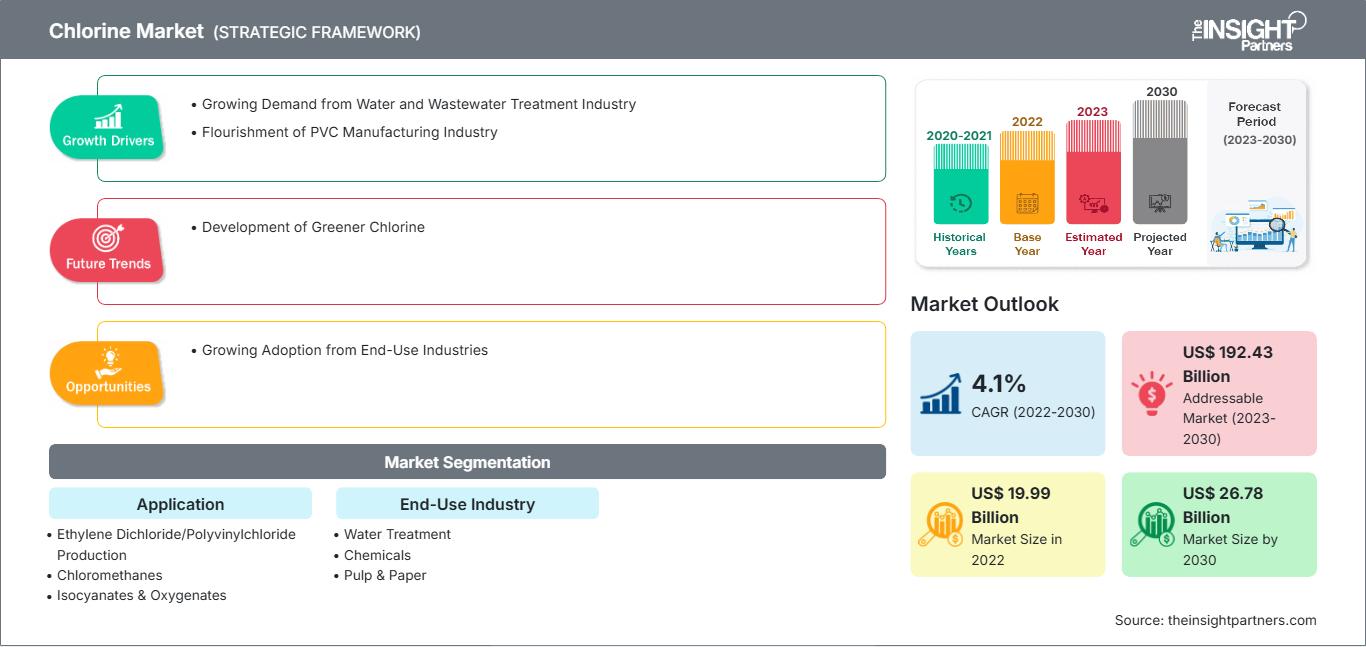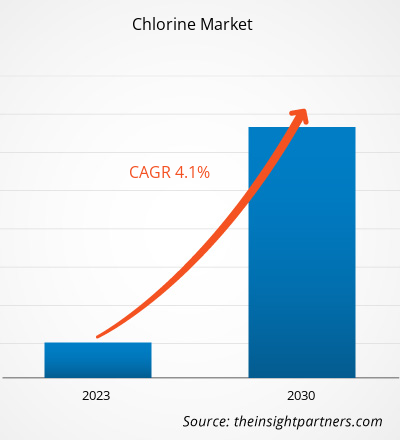[연구 보고서] 염소 시장 규모는 2022년 199억 8,892만 달러로 평가되었으며, 2030년까지 267억 7,766만 달러에 이를 것으로 예상됩니다. 2022년부터 2030년까지 연평균 성장률(CAGR)은 4.1%에 이를 것으로 예상됩니다.
시장 분석 및 분석가 의견:
염소는 수처리, 화학, 펄프 및 제지, 플라스틱 등 다양한 최종 사용자 산업에서 사용되는 다용도 화학물질입니다. 염소는 격막 셀과 막 셀을 사용하여 염화나트륨 용액을 전기분해하여 생산됩니다. 염소는 다양한 분야의 다양한 제품 및 공정에 필수적인 원료입니다. 염소는 도시 정수 처리 시설에서 유해 박테리아, 바이러스 및 기타 병원균을 제거하는 소독제로 널리 사용되어 식수의 안전성과 품질을 보장합니다. 또한 염소는 폴리염화비닐(PVC) 생산의 중요한 성분입니다. PVC는 파이프, 창틀, 바닥재, 포장 필름, 자동차 부품 등의 분야에 사용됩니다. 제약 산업에서는 염소를 사용하여 활성 제약 성분(API) 및 기타 의약품 화합물을 합성합니다. 염소는 농작물 보호 및 농업 생산성 향상을 위한 살충제, 제초제 및 기타 농약 제조에 사용됩니다. 또한 다양한 화학 반응에서 용매, 표백제, 세척제 등 다양한 산업 분야에 사용되는 염소계 화합물을 생산합니다. 염소는 전자 제품 제조 시 부품 접합 및 민감한 부품 보호에 사용됩니다. 이러한 요소들이 염소 시장 성장을 견인할 것으로 예상됩니다.
성장 동력 및 과제:
항생제 내성 박테리아의 증가와 수인성 질병의 출현으로 강력한 물 소독 방법이 중요해졌습니다. 염소는 병원균 제거라는 주요 역할 외에도 조류 및 조류 독소 증식 억제, 철분 및 망간 제거, 기타 수질 문제 해결을 위해 수처리에 사용됩니다. 세계 인구 증가로 인한 물 소비 증가와 안전하고 깨끗한 식수 소비에 대한 필요성 증가로 인해 상하수도 산업에서 염소 수요가 증가하면서 염소 시장 성장이 촉진되고 있습니다. 또한 PVC 필름과 시트는 포장재, 특히 식품 및 의약품 포장재에 널리 사용됩니다. 포장재 수요 증가와 위생 및 제품 안전에 대한 관심 증가로 PVC 기반 포장재 수요가 급증하여 PVC 산업의 염소 수요 증가에 기여하고 있습니다. 전기 분야에서 PVC 케이블과 전선은 우수한 전기적 특성과 난연성으로 인해 전기 절연에 광범위하게 사용됩니다. 전 세계적으로 전기 및 전기 인프라에 대한 수요가 지속적으로 증가함에 따라 PVC 기반 전기 소재에 대한 수요도 증가하고 있으며, 이는 염소 수요 증가로 이어지고 있습니다. PVC는 건설, 자동차, 포장 및 전기 분야에서 여전히 선호되는 소재이기 때문에 중합 공정에서 염소의 필요성은 여전히 높습니다. 따라서 수처리, PVC 제조 및 기타 최종 사용 산업의 수요 증가가 염소 시장 성장을 견인하고 있습니다. 다양한 산업 및 응용 분야에서 염소의 대량 생산, 취급 및 폐기는 인체 건강과 환경에 잠재적 위험을 초래합니다. 전 세계 정부는 이러한 위험을 인식하고 염소의 안전하고 책임감 있는 사용을 보장하기 위해 엄격한 규정을 시행해 왔습니다. 따라서 염소 사용에 대한 우려와 염소 사용 규제 강화는 염소 시장 성장에 부정적인 영향을 미칩니다.
이 보고서의 일부, 국가 수준 분석, Excel 데이터 팩을 포함하여 모든 보고서에 대한 사용자 정의를 무료로 받을 수 있을 뿐만 아니라 스타트업 및 대학을 위한 훌륭한 제안 및 할인을 이용할 수 있습니다
염소 시장: 전략적 통찰력

-
이 보고서의 주요 주요 시장 동향을 확인하세요.이 무료 샘플에는 시장 동향부터 추정 및 예측에 이르기까지 데이터 분석이 포함됩니다.
보고서 세분화 및 범위:
글로벌 염소 시장은 응용 분야, 최종 사용 산업 및 지역을 기준으로 세분화됩니다. 응용 분야별로 염소 시장은 에틸렌 디클로라이드/폴리염화비닐 생산, 클로로메탄, 이소시아네이트 및 산소화제, 용매 등으로 세분화됩니다. 최종 사용 산업 측면에서 염소 시장은 수처리, 화학, 펄프 및 제지, 플라스틱, 제약 등으로 세분화됩니다. 지역별로 염소 시장은 북미(미국, 캐나다, 멕시코), 유럽(독일, 프랑스, 이탈리아, 영국, 러시아 및 기타 유럽), 아시아 태평양(호주, 중국, 일본, 인도, 한국 및 기타 아시아 태평양), 중동 및 아프리카(남아프리카, 사우디아라비아, UAE 및 기타 중동 및 아프리카 지역)와 중남미(브라질, 아르헨티나 및 기타 중남미 지역).
세분화 분석:
용도에 따라 염소 시장은 에틸렌 디클로라이드/폴리염화비닐 생산, 클로로메탄, 이소시아네이트 및 산소화물, 용매 등으로 세분화됩니다. 이소시아네이트 및 산소화물 부문은 2022년부터 2030년까지 상당한 성장을 기록할 것으로 예상됩니다. 이소시아네이트는 폼, 접착제, 실란트, 코팅제 및 엘라스토머에 사용되는 다용도 소재인 폴리우레탄 생산에 광범위하게 사용됩니다. 이러한 폴리우레탄 소재는 가구, 매트리스, 자동차 부품, 단열재 및 신발과 같은 제품에 적용됩니다. 염소는 폴리우레탄 분자에는 존재하지 않지만, 중간체인 이소시아네이트를 만드는 데 사용됩니다.
산소화물은 일반적으로 히드록실기 형태로 산소 원자를 포함하는 광범위한 유기 화합물입니다. 몇 가지 일반적인 산소화물 유형으로는 알코올(예: 에탄올 및 메탄올), 에테르(예: 메틸 tert-부틸 에테르), 케톤(예: 아세톤)이 있습니다. 산소화물은 다양한 산업에서 용매, 연료 첨가제, 화학 중간체로 다양하게 사용됩니다. 예를 들어, 에탄올은 배출 가스를 줄이고 연료 성능을 향상시키는 바이오 연료 첨가제로 사용됩니다. 염소는 염소화 중간체를 포함하는 화학 공정에서 중요한 역할을 합니다. 메탄의 염소화는 염화메틸을 생성할 수 있으며, 이는 일련의 화학 반응을 거쳐 메탄올을 생성합니다. 이러한 모든 요인들이 이소시아네이트 및 염소 시장의 산소화제 부문.
지역 분석:
지리적 특성에 따라 염소 시장은 북미, 유럽, 아시아 태평양, 남미 및 중미, 중동 및 아프리카의 5개 주요 지역으로 구분됩니다. 세계 염소 시장은 아시아 태평양 지역이 주도했으며, 2022년 기준 약 95억 달러의 시장 규모를 기록했습니다. 이 지역은 화학, 섬유, 플라스틱, 전자 등 다양한 산업을 아우르는 세계적인 제조 중심지로 자리매김했습니다. 염소는 화학 물질, 용매, 의약품 중간체 생산 등 다양한 산업 공정에 필수적인 화학물질입니다. 국내외 수요를 충족하기 위한 이 지역의 제조업 활동 증가는 필수 원료인 염소 수요를 촉진할 것으로 예상됩니다. 따라서 이 지역의 발전과 산업화에 따라 염소 및 그 유도체에 대한 수요는 지속적으로 강세를 유지할 것으로 예상되며, 이는 2023년부터 2030년까지 아시아 태평양 지역의 염소 시장 성장을 촉진할 것으로 예상됩니다. 유럽은 2023년부터 2030년까지 4% 이상의 연평균 성장률을 기록할 것으로 예상됩니다. 이 지역은 다양한 용도로 염소 및 그 유도체를 사용하고 있어 이 다재다능한 화학물질에 대한 수요가 꾸준하고 지속적으로 증가하고 있습니다. 유럽의 폐수 처리 부문에서는 염소가 중요한 수질 소독제로서 그 중요성을 강조하는 여러 가지 이유로 염소 수요가 증가하고 있습니다. 유럽 국가들이 수질 개선, 공중 보건 보호, 그리고 엄격한 환경 규제 준수를 위해 노력함에 따라 염소는 폐수 처리를 위한 신뢰성 있고 효과적인 솔루션으로 부상했습니다. 이러한 모든 요인들이 유럽의 염소 시장 성장을 견인하고 있습니다. 북미도 상당한 성장을 보일 것으로 예상되며 2030년에는 55억 달러를 돌파할 것으로 예상됩니다.
산업 개발 및 미래 기회:
염소 시장에서 활동하는 주요 업체가 취한 다양한 이니셔티브는 다음과 같습니다.
- 2022년 12월, INEOS Enterprises는 Bigshire Mexico S. de RL de CV로부터 ASHTA Chemicals 인수를 완료했습니다. 이 거래는 100ktpa 수산화칼륨(KOH)/65kte 염소 공장으로 구성됩니다.
- 2022년 4월, Occidental Petroleum의 화학 부문인 OxyVinyls는 텍사스 주 감사원에 제출된 문서에 따르면 텍사스 주 라포트에 있는 염소-알칼리 공장에서 11억 달러 규모의 확장 및 현대화 프로젝트를 계획하고 있다고 발표했습니다. 사무실.
COVID-19 영향:
COVID-19 팬데믹은 여러 국가의 거의 모든 산업에 악영향을 미쳤습니다. 북미, 유럽, 아시아 태평양(APAC), 중남미, 중동 및 아프리카(MEA) 지역의 봉쇄, 여행 제한, 사업 중단은 화학 및 소재 산업을 포함한 여러 산업의 성장을 저해했습니다. 염소 회사의 생산 시설 폐쇄는 글로벌 공급망, 제조 활동 및 배송 일정에 차질을 빚었습니다. 여러 회사가 2020년에 제품 배송 지연과 제품 판매 부진을 보고했습니다. 팬데믹 기간 동안 대부분의 산업 제조 시설이 폐쇄되어 염소 소비가 감소했습니다. 또한, COVID-19 팬데믹으로 인해 염소 가격 변동이 발생했습니다. 그러나 공급 제약이 해소된 후 여러 산업이 운영을 재개하면서 염소 시장이 다시 활기를 띠었습니다. 게다가 산업 및 주거 부문에서 염소에 대한 수요가 증가함에 따라 염소 시장 성장이 크게 촉진되고 있습니다.
염소
염소 시장 지역별 통찰력The Insight Partners의 분석가들은 예측 기간 동안 염소 시장에 영향을 미치는 지역별 동향과 요인들을 면밀히 분석했습니다. 이 섹션에서는 북미, 유럽, 아시아 태평양, 중동 및 아프리카, 그리고 중남미 지역의 염소 시장 부문과 지역별 분포도 살펴봅니다.
염소 시장 보고서 범위
| 보고서 속성 | 세부 |
|---|---|
| 시장 규모 2022 | US$ 19.99 Billion |
| 시장규모별 2030 | US$ 26.78 Billion |
| 글로벌 CAGR (2022 - 2030) | 4.1% |
| 이전 데이터 | 2020-2021 |
| 예측 기간 | 2023-2030 |
| 다루는 세그먼트 |
By 응용 분야
|
| 포함된 지역 및 국가 |
북미
|
| 시장 선도 기업 및 주요 회사 프로필 |
|
염소 시장 참여자 밀도: 비즈니스 역학에 미치는 영향 이해
염소 시장은 소비자 선호도 변화, 기술 발전, 그리고 제품의 효능에 대한 인식 제고 등의 요인으로 인한 최종 사용자 수요 증가에 힘입어 빠르게 성장하고 있습니다. 수요가 증가함에 따라 기업들은 제품 라인업을 확장하고, 소비자 니즈를 충족하기 위한 혁신을 추진하며, 새로운 트렌드를 적극 활용하고 있으며, 이는 시장 성장을 더욱 가속화하고 있습니다.

- 을 얻으세요 염소 시장 주요 주요 플레이어 개요
경쟁 환경 및 주요 기업:
Aditya Birla Chemicals India Ltd, BASF SE, Ercros SA, Hanwha Solutions Corp, INEOS Group Holdings SA, Occidental Petroleum Corp, Olin Corp, Tata Chemicals Ltd, Vynova Belgium NV, Sumitomo Chemical Co Ltd 등이 글로벌 염소 시장에서 활동하는 주요 기업입니다. 글로벌 염소 시장 참여 기업들은 고객 수요를 충족하는 고품질 제품 제공에 주력합니다.
- 과거 분석(2년), 기준 연도, CAGR을 포함한 예측(7년)
- PEST 및 SWOT 분석
- 시장 규모 가치/거래량 - 글로벌, 지역, 국가
- 산업 및 경쟁 환경
- Excel 데이터세트
최근 보고서
사용 후기
구매 이유
- 정보에 기반한 의사 결정
- 시장 역학 이해
- 경쟁 분석
- 고객 인사이트
- 시장 예측
- 위험 완화
- 전략 기획
- 투자 타당성 분석
- 신흥 시장 파악
- 마케팅 전략 강화
- 운영 효율성 향상
- 규제 동향에 발맞춰 대응






















 무료 샘플 받기 - 염소 시장
무료 샘플 받기 - 염소 시장